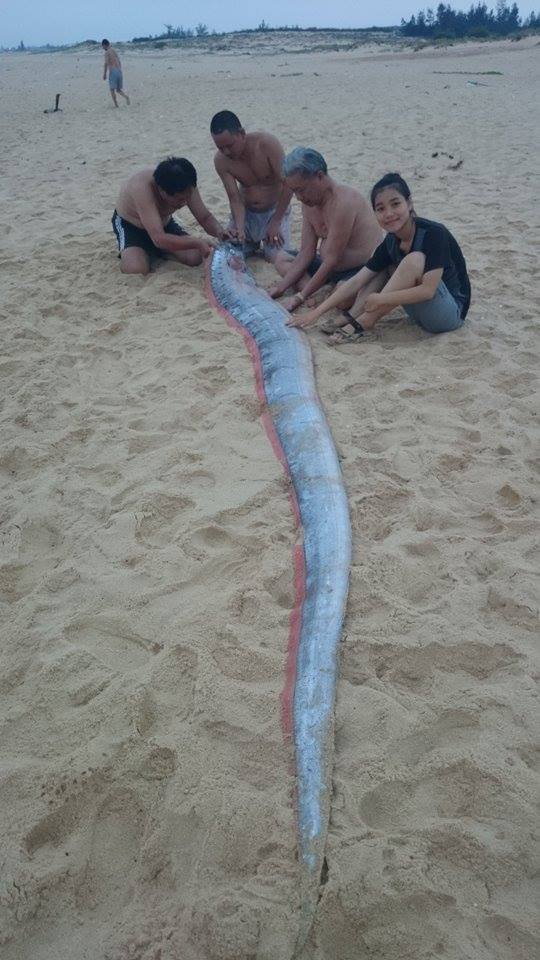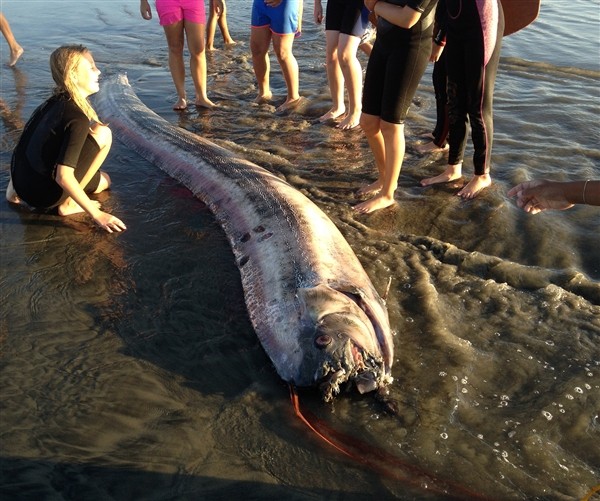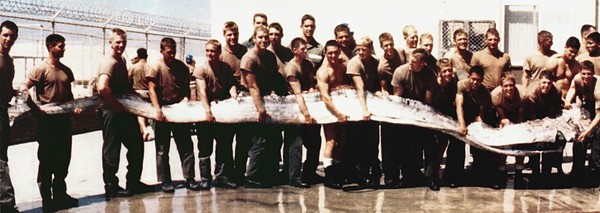The 'sea dragon' has the ability to predict earthquakes that drift into the Vietnamese sea
Many people believe that this fish suddenly drifted to the shore is an omen for natural disasters and earthquakes about to happen. So, what is the truth?
Learn about "sea dragons" capable of forecasting earthquakes floating into the sea of Vietnam
Some sources believe that people in Trung Trach, Bo Trach and Quang Binh districts, on the morning of May 12, caught a fish that was more than 4 meters long drifting to the coast.

Image of giant fish floating on the coast in Quang Binh on 12/5 (Photo: Otofun)
Last year, a Danang fisherman also reported to have caught a 4.2m long fish, weighing 29.6kg in Chan May bay area, Thua Thien Hue province .
According to the initial assessment, this fish is called Oarfish, the scientific name is Regalecus glesne - one of the longest bone fish in the world.
Many rumors blow that Oarfish fish has the ability to forecast natural disasters, so the appearance of Oarfish is an omen of earthquakes. This phenomenon has attracted the attention of scientists of curious people. Learn about this giant fish and decipher the truth about their mysterious abilities through the following article.

The giant oarfish (also known as paddle fish, Regalecus glesne) was first mentioned in 1772, but rarely shows up because they live deep in the ocean - at a depth of 1,000 meters. with sea level.

Oarfish giant fish is the oldest living species known in bone fish, up to 17m long and can weigh up to 270 kg.

Oarfish has a ribbon-like appearance , the body is quite thin and the dorsal fin runs along its entire length. Precisely because of the "huge" length and the special red fin, many people call this fish a giant sea snake, or "sea dragon".

The pectoral fins of the common fish are fat, the pelvic fins are shaped like long paddles. The color of fish is usually silver with black markings and red fins.

Oarfish fish have no fins, but a silver coat containing guanine - a substance that is abundant in fins of some fish. Although they are adapted to survive under high pressure, the Oarfish fish skin is very soft and vulnerable.

Despite the "giant" body, Oarfish fish have no teeth but often catch prey with gills. Accordingly, they suck water into the mouth, discharge water through the gills, filter and retain small foods. Oarfish's favorite food is small molluscs or crustaceans such as small fish or squid.


For a long time, many Japanese believed, when they discovered Oarfish's body floated ashore - that was the premonition of an earthquake.
This belief comes from a Japanese legend that says Oarfish's body drifted from the coast is a message from the palace of the sea god.

Many scientists have rejected this information. They said that a few studies were conducted showing that there was a particularly large oscillation recorded before the earthquake, coinciding with the decline in animal activity observed in the pre-earthquake period. .

Accordingly, positive ions in the air are the culprits leading to unpleasant side effects in both humans and animals. For example, hyper serotonin syndrome in the blood - leading to symptoms of restlessness, anxiety, hyperactivity .
In a study involving toads, the scientific community noted that toad activity coincides with seismic disturbances in the ionosphere, so it was possible to detect low frequency radio waves (VLF).

Despite this, scientists still have not learned any experience from their research on what causes the abnormal behavior of toads.
Regarding the Oarfish fish, experts say that, because they live near the sea floor, they are more sensitive to soil movements than those near the sea. However, whether or not this fish has the ability to predict earthquakes or not has no scientific research to prove it.
- Toads can predict earthquakes
- Toads have the ability to predict earthquakes
- Can predict a child's ability to learn?
- What causes earthquakes and tsunamis?
- 4 Vietnamese were stranded in houses collapsed due to the Taiwan earthquake
- Animals can predict earthquakes
- China uses chickens, fish, toads to predict earthquakes
- The ability to predict the magic of animals
- The aquatic monster looks at the earthquake and the Japanese for more than two centuries
- Successful breeding of dragon fruit with purple-pink gut
- Ability to predict natural disasters and cancer detection of animals
- Red ants predict earthquakes
 Animal 'suffering' after hibernation
Animal 'suffering' after hibernation Why do goats climb well?
Why do goats climb well? Scientists were surprised to see chimpanzees eating turtles
Scientists were surprised to see chimpanzees eating turtles Giant catfish died deadly due to drought in Thailand
Giant catfish died deadly due to drought in Thailand